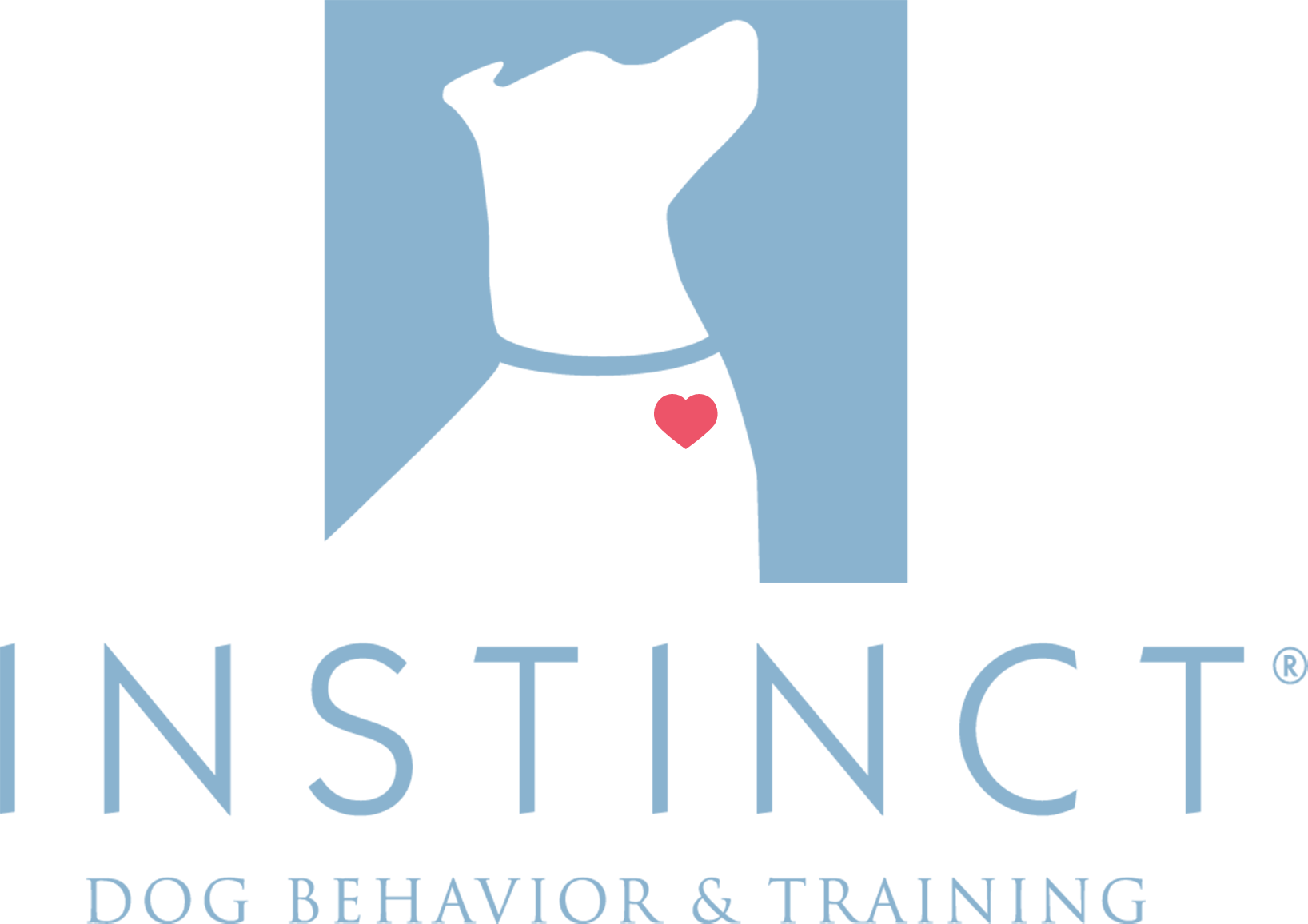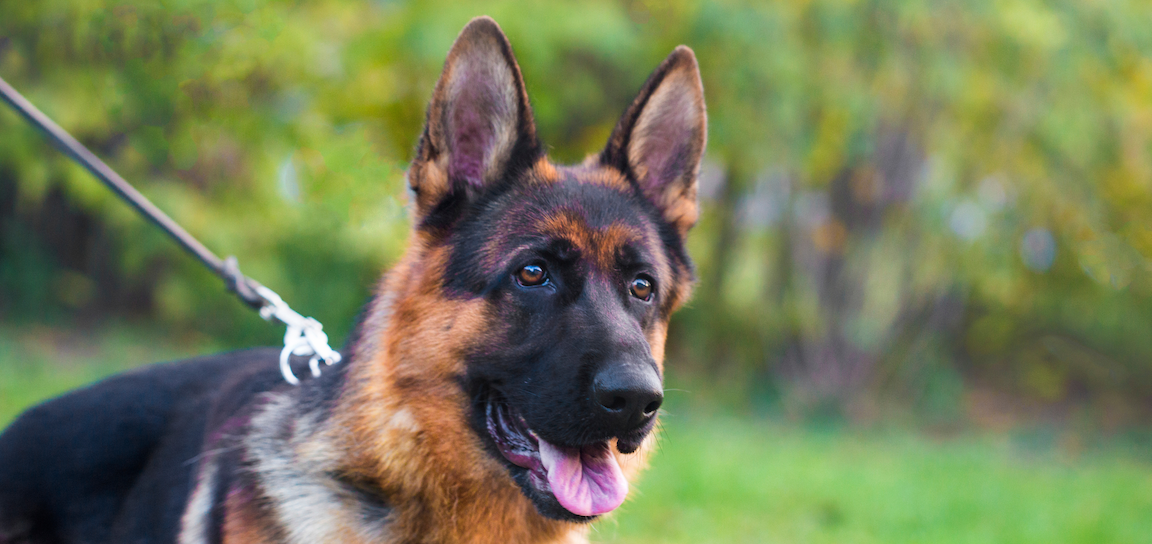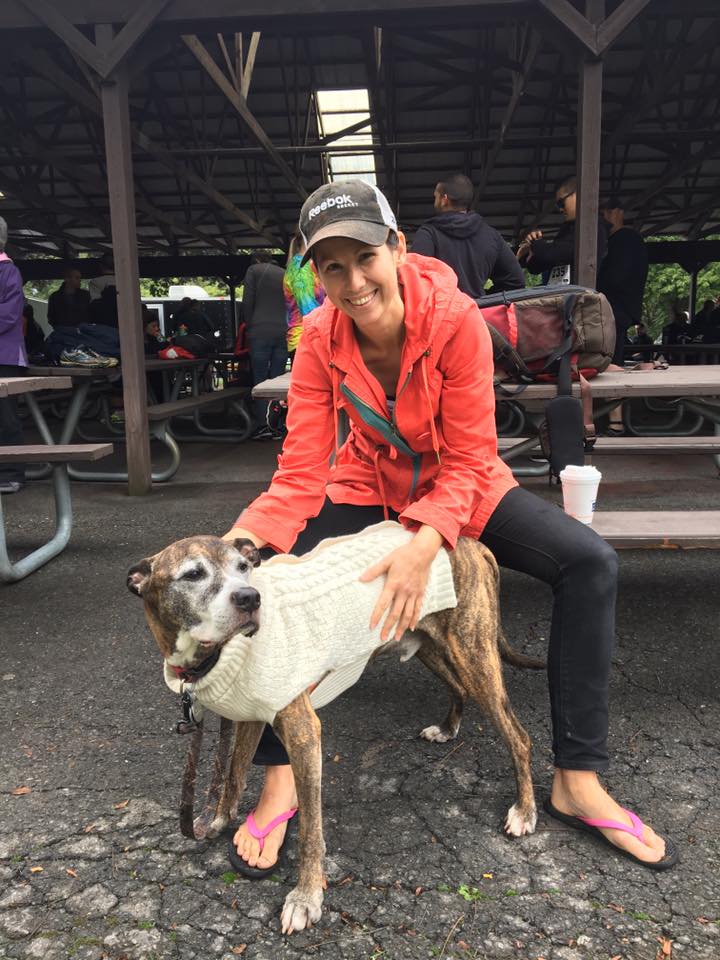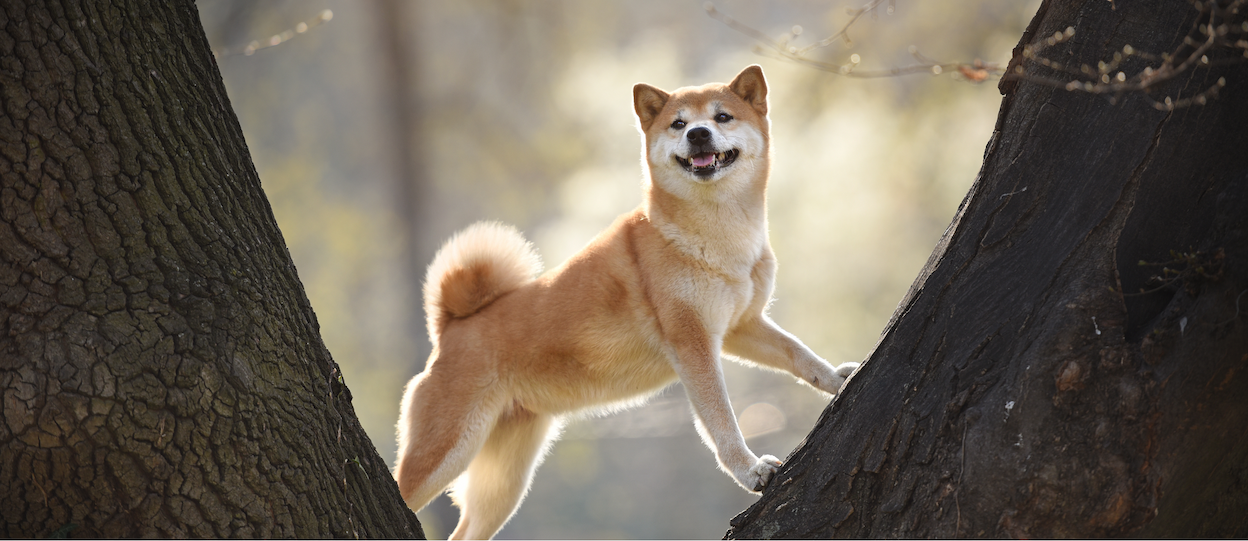
Welcome to the Instinct blog! This week, we’re talking about how to help dogs who get really worked up when their owner returns home – whether that overexcitement shows up as jumping, barking, peeing, zooming around the house, or all of the above!
Happy Reading,

How to Create More Peaceful, Less Chaotic Homecomings
Does your dog lose their mind with excitement when you return home after leaving them alone? It’s totally normal for dogs to express their joy at seeing you after spending time apart. But sometimes, that joy can tip over into frantic, over-the-top excitement that’s not terribly fun for you or them.
Whether your dog is barking, jumping all over you, peeing from overexcitement, or all of the above, read on for some simple tips to you can use to create less chaotic homecomings.
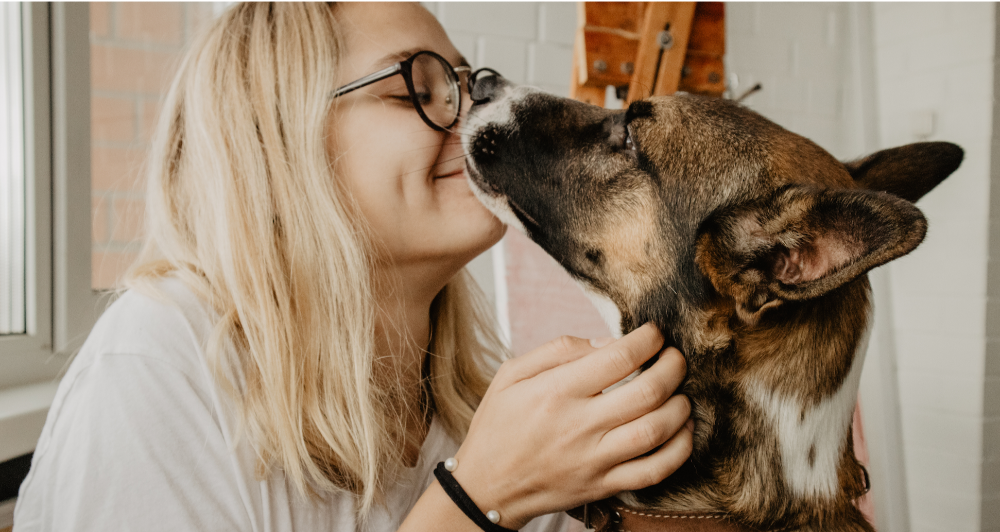
Step 1: Examine Your Own Behavior
First things first, it’s important to take an honest look at your own greeting behavior with your dog:
- Are you adding lots of excited energy to the situation (“Squeeeaal, I’m SO HAPPY TO SEE YOU TOO, BUDDY!!!”)?
- Are you inconsistent in your responses—sometimes engaging in hugs and snuggles when your dog jumps, but other times scolding them for doing so?
- Are you trying to completely ignore your dog, pretending they don’t exist until they calm down? (This is super common advice, and while it’s not necessarily bad/wrong, we find it generally works better with a couple of tweaks)
Regardless of the specific technique you end up choosing for you and your dog, try doing the following as you return home, to establish yourself as a calm, confident and predictable presence:
- Before you open the door, take a deep breath and relax your facial muscles. Dogs are very perceptive and are acutely aware of human facial expressions – tension you carry in the door from work can be perceived as being directed at them
- Focus on your objective: to SOOTHE your overexcited pup and help them feel happy and *peaceful* again
- As you enter, say a brief greeting (“Hey Buddy, I missed you too”) in a warm, calm voice
- The initial acknowledgement is important so your dog doesn’t worry that they’ve suddenly become invisible 😉 . Seriously though, wouldn’t it seem odd if your friend or partner walked through the door and acted completely oblivious to your presence, even as you tried in earnest to greet them with a warm hello?
- Keep your movements natural and purposeful
- Move immediately into your chosen calming technique
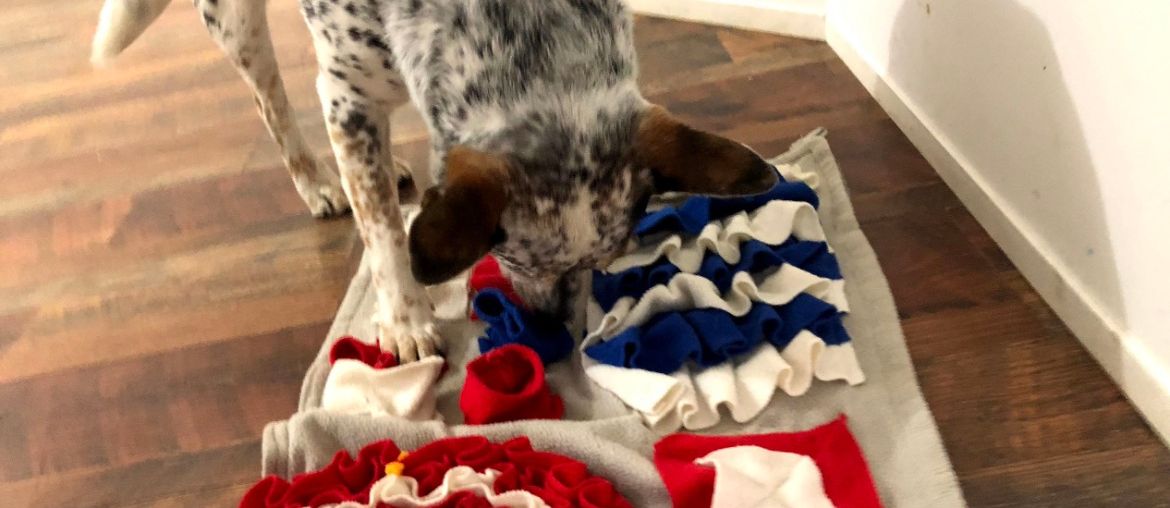
Step 2: Find the Right Calming Technique
Here are six common techniques we use to help dogs feel less frantic when their owners return home.
Note: Be prepared to try a given technique anywhere from 4-6 times to determine whether it’s a good fit for your dog. It will take more repetitions than that to build new, calmer greeting habits, but those initial 4-6 repetitions are usually enough for you to tell whether a particular technique shows signs of promise.

How to do it:
- Place a treat jar at your door
- As you enter, grab a big handful of treats.
- As your dog approaches you, throw the treats on the ground in front of her, before she jumps (Treat Bomb!)
- For some dogs, dropping the treats on a snuffle mat, instead of on the ground, can facilitate quicker relaxation
- You can help by pointing out some of the treats to your dog
- Keep a few extra treats in your hand
- As your dog finishes the Treat Bomb, offer a few more treats from your hand, so long as four paws stay on the ground
- Check out our blog for complete instructions and a video tutorial
Great for: Dogs who find foraging activities satisfying and relaxing (e.g., dogs who become calmer after using a snuffle mat or searching for treats in the grass)
Not So Great for: Multi-dog households

How to do it:
- Purchase 4-6 classic KONGs or similar stuffable toys, along with a couple of cans of KONG stuffing or spray cheese (we’re opting for convenience – if there’s another, healthier/“cleaner” stuffing option that works for you to keep right by the door, go for it!)
- Place the KONGs and stuffing in a basket by your front door, out of your dog’s reach but easily accessible
- When you enter your home, grab a KONG from the basket and spray some filling inside
- Present the KONG at your dog’s nose level and allow them to lick at the filling for a few seconds
- Keeping the KONG at nose level, walk them over to their dog bed or a favorite resting spot, and set the Kong down for them to work on
- Check out a full set of instructions for the KONG station on our blog
Great for: Almost dogs all dogs, with the exception of dogs who are too worked up to lick at the KONG, even when you hold it right at nose level for them

How to do it:
- Place a basket of toys right next to the door (include a selection of your dog’s favorites – whether that be squeaky balls, stuffies, or tug-friendly options like rope toys)
- As you enter, go to the basket and encourage your dog to take out a toy of their choosing
- If they don’t/can’t choose for themselves in the moment
- Depending on their preference, give the toy a toss for them to go get, or invite them to grab hold for a quick game of tug.
- Keep in mind that, when arousal levels are really high, you’ll want to start with just 1-2 seconds of tug, then let your dog ‘win’
- If your dog takes the toy and parades around happily, leave them be – this is a win! If they come back to play more, reengage them in the game for a few more seconds.
- Repeat for 4-6 short games of tug, then say “all done” and give some (very calm) pets and/or go about your business
Great for: Dogs who really want to put something in their mouth when they’re feeling excited (retrievers and bully breeds come to mind, as a broad generalization, though individual dogs from all breed groups can fall into this category); dogs who love toys
Not So Great for: Dogs who currently get mouthy, jumpy and/or bitey around toys in general—that’s an issue you’d want to work through separately, at a less emotionally-charged time

How to do it:
- Keep a treat jar next to your door. As you enter, grab a handful
- Start off by asking your dog for their BEST/EASIEST skill; for many dogs, this is often a Sit or a Touch (hand target) behavior
- When they perform the behavior, give a calm-but-happy ‘good’ or ‘yes’, then toss a treat away from you for them to retrieve
- Repeat with a simple/easy skill and toss a treat away again
- Then, try an easy skill, but hand feed instead of tossing the treat
- Next time, ask for a slightly harder skill
- Over the span of 2-3 minutes, work your way up to asking your dog to do a Down and Stay—at first just for a few seconds, then building up to 20-30 seconds at a time (you may find it helpful to reward them frequently in the early part of the stay)
- Your goal is to focus your dog’s energy on performing some fun skills, starting with easy reps that give your dog the opportunity to move their body at first as they work off their highest levels of excitement and ‘find their brain’, then shifting to a more relaxing, lower-energy skill that’s conducive to helping reduce their level of excitement
Great for: Dogs who thrive when given very clear direction and guidance; dogs who generally seem content and mentally tired after you engage them in a mini training session at other times of day
Not So Great for: Dogs who have conflicted feelings about performing ‘obedience’ cues – for example, dogs who may display agitated barking, jump up or paw at you, or move away from you when asked to do something (that’s an issue to work through at another time)

How to do it:
- Staying calm, quiet, and relaxed, kneel down on one knee and slip your thumb under the front of your dog’s collar or harness, so their collar is touching the skin between your thumb and index finger
- Hold your hand steady at a level where your dog can stand comfortably, but is unable to jump up
- If/when your dog tries to jump, don’t say anything. Just stay calm and relaxed and let your thumb through their collar act as a sort of tether to prevent upward movement.
- Important: It can be natural to reflexively pull down toward the ground as your dog tries to jump. Resist the urge to do so! Just keep your hand steadily anchored in position
- Exude calmness. Be sure to keep your facial muscles relaxed; avoid prolonged eye contact, and breathe slowly. I find it helpful to keep my chin pointed slightly up and away from my dog, to avoid an accidental headbutt to the face!
- When your dog’s front paws are planted on the ground, give them slow, massage-style pets on their chest or side. Really embrace the mindset of trying to SOOTHE your dog.
Note:
You’ll know this is likely a good choice for your dog if all of their energy and focus is directed toward you (trying to jump toward and lick your face, trying to jump and lean into you, etc) when you start the technique. This is a dog who REALLY wants to reconnect and engage with you direct after time apart. Stick it out for another 4-6 trials to see how it progresses. You’ll be showing your dog a new, more relaxing way to get what they want most: connection with you.
If your dog is mostly trying to bounce/pull AWAY from you, or if they become bitey/mouthy when you try this technique, it likely isn’t the best choice for them. Abort and try a different technique next time.
Great for: Dogs who truly love petting and physical attention. These are dogs who often melt into pets, and who love leaning their whole body into you in moments when they are less worked up.
Not So Great for: Dogs with handling issues; dogs who quickly become concerned or agitated about any sort of restraint

How to do it:
- Give your dog a brief but warm verbal greeting as described in Step 1
- Then, go about your business, largely ignoring any shenanigans or attention-seeking behavior until your dog starts to settle
Great for: Dogs who get really aroused/amped up about treats, toys, or petting in general; owners who find the other techniques challenging to implement while remaining calm and relaxed themselves
Not So Great for: Dogs who escalate their attention-seeking behavior into nipping/mouthing and/or persistent jumping and clawing at their person when ignored. In these cases, it can be helpful to work with a behavior consultant on a safe, practical, and effective greeting routine (along with additional skill building, if needed)
Overexcited Dog in a Crate or Behind a Gate?
You can still implement most of the above techniques (except kneel-and-soothe) while your dog is in their crate or behind a gate. Once your dog calms down a little in the crate, you can let them out, then repeat the technique(s) again if needed.
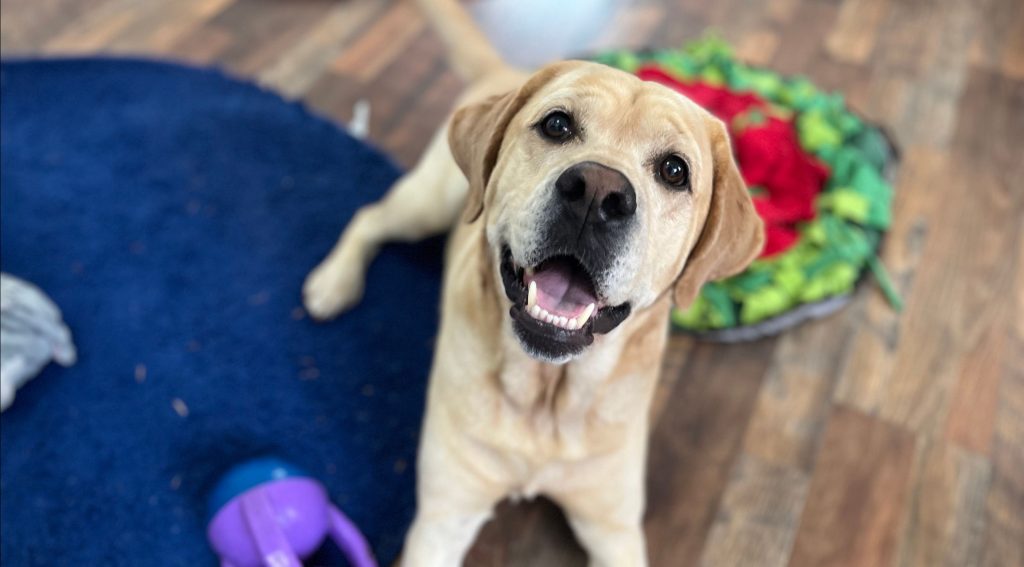
Step 2a: Transition to Relaxing on a Bed (If Needed)
For some dogs, you may find that, while the techniques above effectively bring their excitement down from a level 10 to a level 6 or 7, they require some extra guidance to return to a fully relaxed, peaceful baseline.
For these types of dogs, try asking your dog to relax on their bed for a few minutes, immediately after you employ a treat bomb, a brief game of fetch, or a few tricks:
- Walk over to your dog’s bed with a handful of treats.
- Direct them onto the bed and into a down position; for some dogs, eliminating verbal cues/feedback and relying only on hand signals can help them settle more quickly
- Begin rewarding your dog by placing a treat between their paws. Continue to reward every 3-4 seconds, then every 5-6, then every 8-10, as they stay in a down position on their bed for anywhere from 1-2 minutes.
- Watch for signs that your dog is starting to relax: their body and eyes soften, their breathing slows, etc.
- Then, casually and quietly say, “all done” and go about your business at home.
All of the above techniques can be mixed & matched to suit your dog’s individual needs. For some dogs, it’s really effective to use the Relax on a Bed technique as your initial intervention, then transition into giving a Kong or long lasting chew, or doing the “kneel and soothe”. For other dogs who are highly physiologically aroused (read: AMPED UP), they might benefit from doing a Treat Bomb followed by a few simple tricks, THEN being given a Kong on their bed. Don’t be afraid to experiment. Try out different combinations and observe your dog’s behavior to discover works for them! If that sounds overwhelming, remember that you can always reach out to your local Instinct team for some expert guidance.
MIX & MATCH TO SUIT YOUR DOG
All of the above techniques can be mixed & matched to suit your dog’s individual needs. For some dogs, it’s really effective to use the Relax on a Bed technique as your initial intervention, then transition into giving a Kong or long lasting chew, or doing the “kneel and soothe”. For other dogs who are highly physiologically aroused (read: AMPED UP), they might benefit from doing a Treat Bomb followed by a few simple tricks, THEN being given a Kong on their bed.
Don’t be afraid to experiment. Try out different combinations and observe your dog’s behavior to discover works for them! If that sounds overwhelming, remember that you can always reach out to your local Instinct team for some expert guidance.
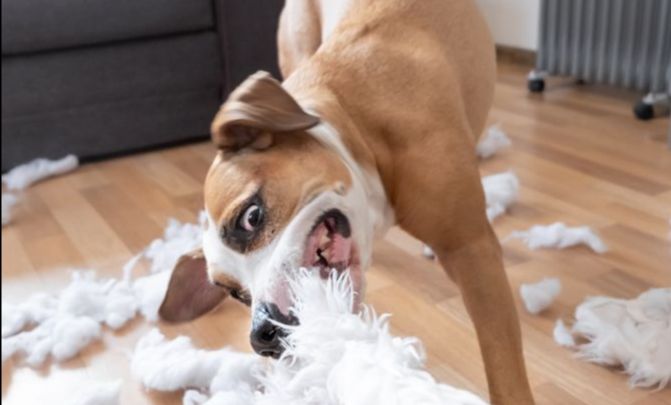
What If My Dog Still Can’t Settle After 10+ Minutes?
If your dog really struggles to calm down—that is, if they remain highly excited for 10 minutes or longer—it may be a sign that there’s more going on than just some happy exuberance about your arrival home.
A few potential reasons that dogs remain highly aroused and excited for long periods after reuniting with their owner include:
- An excess of energy (mental and/or physical)
- If you think this may be the case, try incorporating some more physical activity and/or enrichment into your dog’s routine for a few weeks to see if you notice a difference
- A need for more social connection
- In these cases, it’s helpful to build more play and interaction into your daily routine
- Feeling conflicted about your return, either from experiences with you OR experiences they had prior to joining your family
- Sometimes, dogs can be REALLY excited that their person has returned, while also feeling concerned they might suddenly get in trouble for some (unknown to them) reason
- Common examples of this include a dog who has been reprimanded for house soiling or destructive behavior when the owner returns home; or, dogs who are sometimes scolded for jumping up excitedly
- This conflict can often manifest as overexcited behaviors like persistent jumping/pawing, barking, heavy panting, and/or zooming around
- Keep in mind: If this describe your dog, you may not be acting harshly or aggressively. Some dogs are just very sensitive, and can develop these conflicted feelings if an owner often arrives home feeling agitated or angry about something else entirely.
- Sometimes, dogs can be REALLY excited that their person has returned, while also feeling concerned they might suddenly get in trouble for some (unknown to them) reason
- An anxious, insecure attachment to you
- Some—though not all—dogs with anxious/insecure attachments also display separation-related behaviors
- In these cases, it’s often most helpful to connect with a behavior consultant to map out a plan to help your dog build a more secure bond
Be Consistent
When you land on an approach that feels good to both you and your dog, try to be super consistent and engage in that same routine every time you come home, so your arrival becomes a very predictable event.
Over time, as your dog transitions into being happy but not over-the-top excited at your return, you can generally fade out or greatly reduce any food rewards you might be using.
NEED TRAINING OR BEHAVIOR SUPPORT?
Check out the resources below!
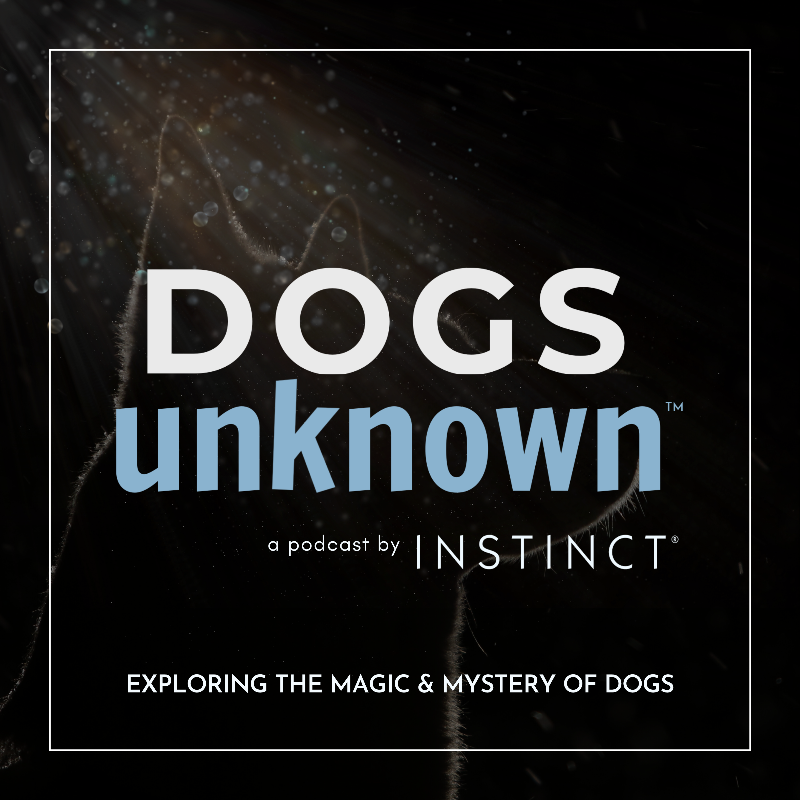
Check out Instinct’s award-winning podcast, Dogs Unknown (fka DogLab), hosted by Instinct Co-Founders Sarah Fraser (me!) and Brian Burton.

Join one of our free, live training & behavior seminars via Zoom!
Hosted by Instinct behavior consultants, these seminars include a 1 hr presentation plus live Q&A session. Open to all!
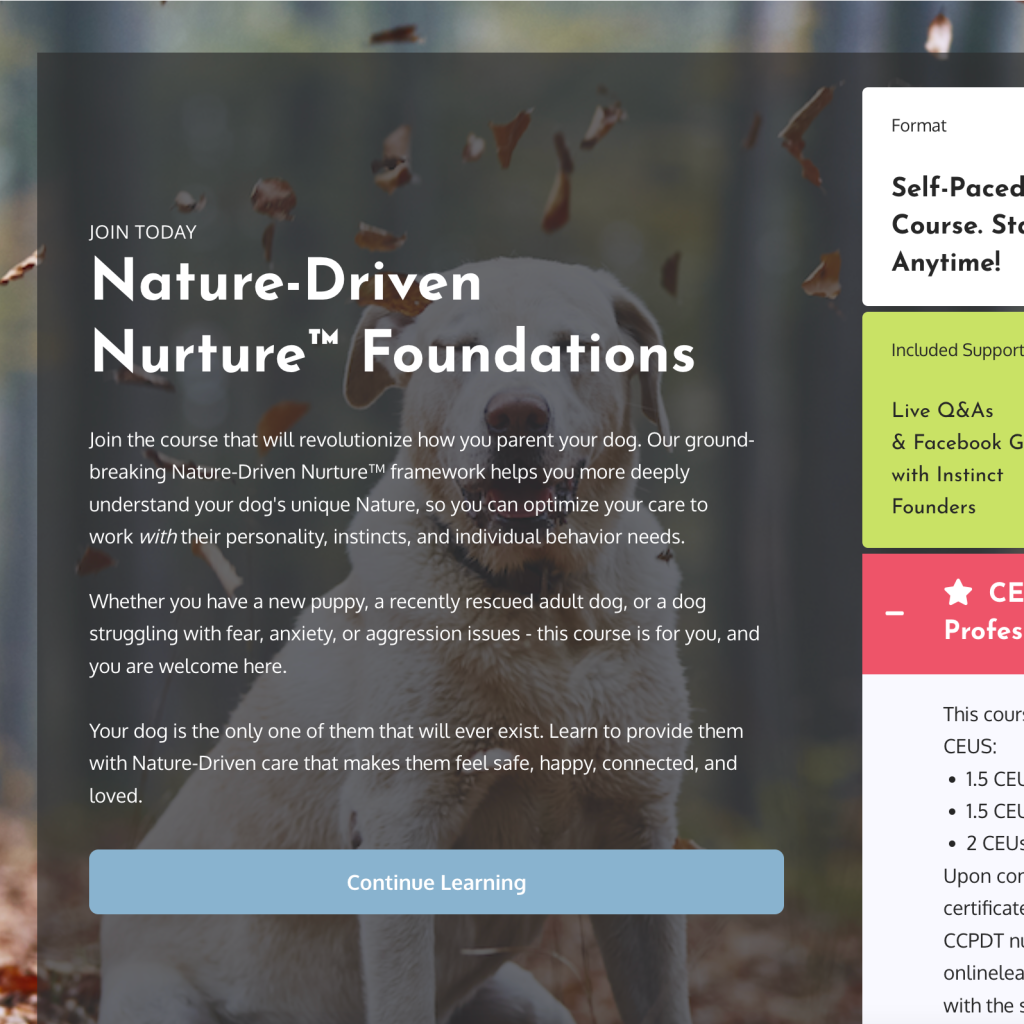
Sign up for the Nature-Driven Nurture Foundations course in our Online School. Learn our groundbreaking canine behavioral health framework that teaches you how to optimize your dog’s training & care based on their unique, individual Nature. This self-paced course includes:
- Access to private Alumni Facebook group
- Twice-monthly Zoom Q&As with Instinct co-founders
Or, contact your local Instinct for fully customized training & behavior support with certified, veterinarian-recommended trainers and behavior consultants.
